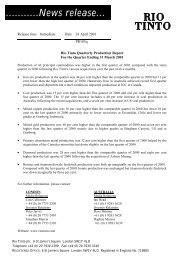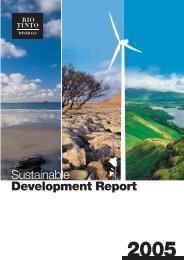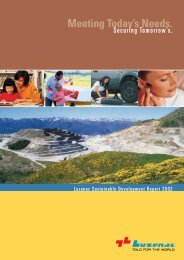Luzenac 20-pages - Rio Tinto
Luzenac 20-pages - Rio Tinto
Luzenac 20-pages - Rio Tinto
Create successful ePaper yourself
Turn your PDF publications into a flip-book with our unique Google optimized e-Paper software.
european commission<br />
4 <strong>Luzenac</strong><br />
Sustainable development<br />
indicators for the EU non-energy<br />
extractive industry<br />
European Commission voluntary<br />
scheme for collecting and reporting<br />
industry data<br />
In the millennium year, the European Commission began a process of<br />
engagement with the industrial minerals industry and its stakeholders<br />
on the subject of sustainable development.<br />
Europe is rich in natural resources and the extraction and<br />
supply of minerals play a crucial role in the European<br />
economy and society. Minerals provide many of the basic raw<br />
materials that are essential for modern society, including<br />
construction materials for the building of homes and roads, metals<br />
for the production of cars and mobile phones, and specialist<br />
minerals used in agriculture, pharmaceutical products and other<br />
industrial processes.<br />
However, mineral extraction can have significant environmental<br />
effects if it is not properly controlled. In the last twenty years,<br />
a number of incidents at mining sites coupled with shifting public<br />
awareness concerning the environmental and societal performance<br />
of industry has led to a change in European policy<br />
strategies—requiring more secure and responsible industries<br />
whilst maintaining the competitiveness of the different sectors.<br />
In May <strong>20</strong>00, the European Commission published a<br />
Communication on promoting sustainable development in the EU<br />
non-energy extractive industry. The Communication identified the<br />
need for more transparency and improved dialogue between the<br />
main stakeholders and for more voluntary initiatives—all of which<br />
are key to achieving a sustainable minerals industry.<br />
The extractive industry responded positively and under the<br />
auspices of the DG Enterprise’s Raw Materials Supply Group has<br />
been working to develop sustainable development indicators for<br />
this sector. The indicators cover the three pillars of sustainable<br />
development—environmental, social and economic—and include<br />
the use of dangerous substances, communication with the local<br />
community, health and safety, and land use. This is the first<br />
time that SD indicators have been gathered and published<br />
in this way. They provide an insight into the key areas of<br />
interest to communities and public policy makers.<br />
<strong>Luzenac</strong> played a key role in the creation of the voluntary<br />
reporting scheme, serving on the Working Group,<br />
alongside Government, NGO and other industry groups, as<br />
the official representative of the European Industrial<br />
Minerals Association.<br />
The scheme is now up and running and the results of the<br />
first data collection exercise, covering the year <strong>20</strong>01, can be<br />
accessed at the following web address:<br />
http://europa.eu.int/comm/enterprise/steel/non-energy-extractive-industry/sd-indicators.htm<br />
<strong>Luzenac</strong> is committed to providing this data for its<br />
European operations and to urging others to do likewise.<br />
It is our hope that this voluntary scheme will grow and that<br />
it will provide a mechanism for improved SD performance<br />
across the whole industry as well as demonstrate to policy<br />
makers and land use planners the need to nurture our<br />
industry.<br />
For <strong>20</strong>01 SD Indicator data for the EU Industrial Minerals<br />
industry see page 19. ¬



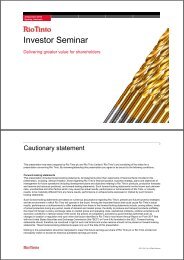


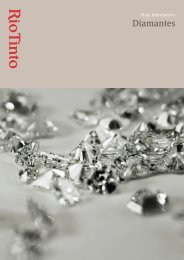

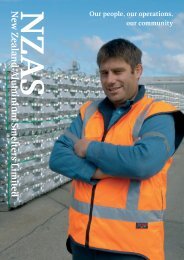
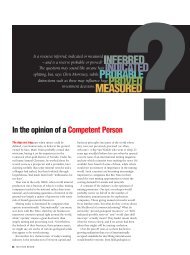
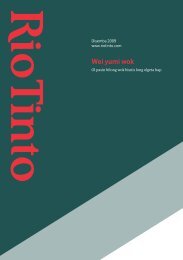

![Download pdf file [PDF: 1.26 MB] - Rio Tinto](https://img.yumpu.com/10319684/1/190x253/download-pdf-file-pdf-126-mb-rio-tinto.jpg?quality=85)

